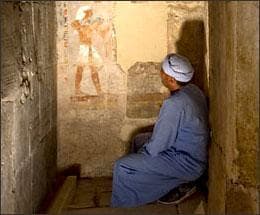Advertisement
Egypt's She-King
Resume
3,500 years ago in the heart of ancient Egypt, in the heyday of the pharaohs, a woman took the throne.
A great king had died. A step-son and heir was too young to rule. The pharaoh, queen, Hatshepsut, stepped into power – and stayed there.
She built. She commanded armies. She wore the ceremonial fake beard of a pharaoh’s regalia. And when she had died, her stepson chiseled her name off every monument he could reach. Her mummy vanished to history. Now it’s back, and a new story is emerging.
This hour, On Point: Hatshepsut, the great “she-king” of Egypt.
You can join the conversation. How far do you think we can really understand what went on in one grand life in ancient Egypt, 3,500 years ago?Guests:
Joining us from New York is Chip Brown, author of "The She-King of Egypt," the cover story in the current issue of National Geographic.
See the stunning gallery of photos by Kenneth Garrett, accompanying Chip Brown's article, at nationalgeographic.com.And joining us from Cairo, Egypt, is Zahi Hawass, world-renowned archaeologist and Egyptologist who led the effort that positively identified the mummy of Queen Hatshepsut in 2007. (Click here for an image of the Hatshepsut CT scan.) He is Secretary General of Egypt’s Supreme Council of Antiquities and leader of the Egyptian Mummy Project, which uses modern science — including CT scanning and DNA analysis — to learn more about ancient Egyptian mummies. Among other projects, Dr. Hawass is currently leading the search for the tomb of Cleopatra and Marc Antony.
This program aired on April 9, 2009.